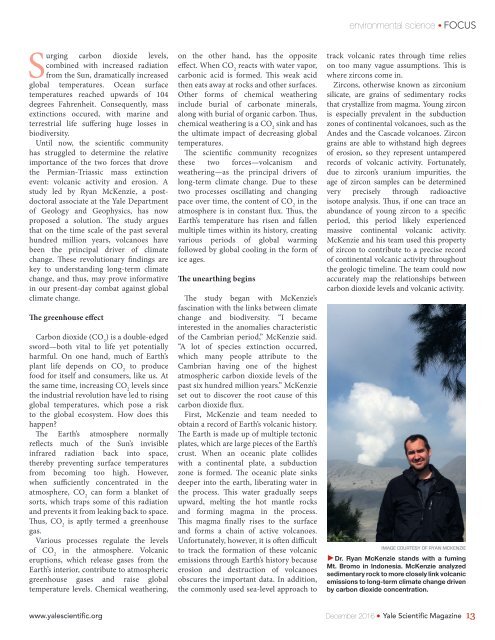YSM Issue 90.1
Create successful ePaper yourself
Turn your PDF publications into a flip-book with our unique Google optimized e-Paper software.
environmental science<br />
FOCUS<br />
Surging carbon dioxide levels,<br />
combined with increased radiation<br />
from the Sun, dramatically increased<br />
global temperatures. Ocean surface<br />
temperatures reached upwards of 104<br />
degrees Fahrenheit. Consequently, mass<br />
extinctions occured, with marine and<br />
terrestrial life suffering huge losses in<br />
biodiversity.<br />
Until now, the scientific community<br />
has struggled to determine the relative<br />
importance of the two forces that drove<br />
the Permian-Triassic mass extinction<br />
event: volcanic activity and erosion. A<br />
study led by Ryan McKenzie, a postdoctoral<br />
associate at the Yale Department<br />
of Geology and Geophysics, has now<br />
proposed a solution. The study argues<br />
that on the time scale of the past several<br />
hundred million years, volcanoes have<br />
been the principal driver of climate<br />
change. These revolutionary findings are<br />
key to understanding long-term climate<br />
change, and thus, may prove informative<br />
in our present-day combat against global<br />
climate change.<br />
The greenhouse effect<br />
Carbon dioxide (CO 2<br />
) is a double-edged<br />
sword—both vital to life yet potentially<br />
harmful. On one hand, much of Earth’s<br />
plant life depends on CO 2<br />
to produce<br />
food for itself and consumers, like us. At<br />
the same time, increasing CO 2<br />
levels since<br />
the industrial revolution have led to rising<br />
global temperatures, which pose a risk<br />
to the global ecosystem. How does this<br />
happen?<br />
The Earth’s atmosphere normally<br />
reflects much of the Sun’s invisible<br />
infrared radiation back into space,<br />
thereby preventing surface temperatures<br />
from becoming too high. However,<br />
when sufficiently concentrated in the<br />
atmosphere, CO 2<br />
can form a blanket of<br />
sorts, which traps some of this radiation<br />
and prevents it from leaking back to space.<br />
Thus, CO 2<br />
is aptly termed a greenhouse<br />
gas.<br />
Various processes regulate the levels<br />
of CO 2<br />
in the atmosphere. Volcanic<br />
eruptions, which release gases from the<br />
Earth’s interior, contribute to atmospheric<br />
greenhouse gases and raise global<br />
temperature levels. Chemical weathering,<br />
on the other hand, has the opposite<br />
effect. When CO 2<br />
reacts with water vapor,<br />
carbonic acid is formed. This weak acid<br />
then eats away at rocks and other surfaces.<br />
Other forms of chemical weathering<br />
include burial of carbonate minerals,<br />
along with burial of organic carbon. Thus,<br />
chemical weathering is a CO 2<br />
sink and has<br />
the ultimate impact of decreasing global<br />
temperatures.<br />
The scientific community recognizes<br />
these two forces—volcanism and<br />
weathering—as the principal drivers of<br />
long-term climate change. Due to these<br />
two processes oscillating and changing<br />
pace over time, the content of CO 2<br />
in the<br />
atmosphere is in constant flux. Thus, the<br />
Earth’s temperature has risen and fallen<br />
multiple times within its history, creating<br />
various periods of global warming<br />
followed by global cooling in the form of<br />
ice ages.<br />
The unearthing begins<br />
The study began with McKenzie’s<br />
fascination with the links between climate<br />
change and biodiversity. “I became<br />
interested in the anomalies characteristic<br />
of the Cambrian period,” McKenzie said.<br />
“A lot of species extinction occurred,<br />
which many people attribute to the<br />
Cambrian having one of the highest<br />
atmospheric carbon dioxide levels of the<br />
past six hundred million years.” McKenzie<br />
set out to discover the root cause of this<br />
carbon dioxide flux.<br />
First, McKenzie and team needed to<br />
obtain a record of Earth’s volcanic history.<br />
The Earth is made up of multiple tectonic<br />
plates, which are large pieces of the Earth’s<br />
crust. When an oceanic plate collides<br />
with a continental plate, a subduction<br />
zone is formed. The oceanic plate sinks<br />
deeper into the earth, liberating water in<br />
the process. This water gradually seeps<br />
upward, melting the hot mantle rocks<br />
and forming magma in the process.<br />
This magma finally rises to the surface<br />
and forms a chain of active volcanoes.<br />
Unfortunately, however, it is often difficult<br />
to track the formation of these volcanic<br />
emissions through Earth’s history because<br />
erosion and destruction of volcanoes<br />
obscures the important data. In addition,<br />
the commonly used sea-level approach to<br />
track volcanic rates through time relies<br />
on too many vague assumptions. This is<br />
where zircons come in.<br />
Zircons, otherwise known as zirconium<br />
silicate, are grains of sedimentary rocks<br />
that crystallize from magma. Young zircon<br />
is especially prevalent in the subduction<br />
zones of continental volcanoes, such as the<br />
Andes and the Cascade volcanoes. Zircon<br />
grains are able to withstand high degrees<br />
of erosion, so they represent untampered<br />
records of volcanic activity. Fortunately,<br />
due to zircon’s uranium impurities, the<br />
age of zircon samples can be determined<br />
very precisely through radioactive<br />
isotope analysis. Thus, if one can trace an<br />
abundance of young zircon to a specific<br />
period, this period likely experienced<br />
massive continental volcanic activity.<br />
McKenzie and his team used this property<br />
of zircon to contribute to a precise record<br />
of continental volcanic activity throughout<br />
the geologic timeline. The team could now<br />
accurately map the relationships between<br />
carbon dioxide levels and volcanic activity.<br />
IMAGE COURTESY OF RYAN MCKENZIE<br />
►Dr. Ryan McKenzie stands with a fuming<br />
Mt. Bromo in Indonesia. McKenzie analyzed<br />
sedimentary rock to more closely link volcanic<br />
emissions to long-term climate change driven<br />
by carbon dioxide concentration.<br />
www.yalescientific.org<br />
December 2016<br />
Yale Scientific Magazine<br />
13


















